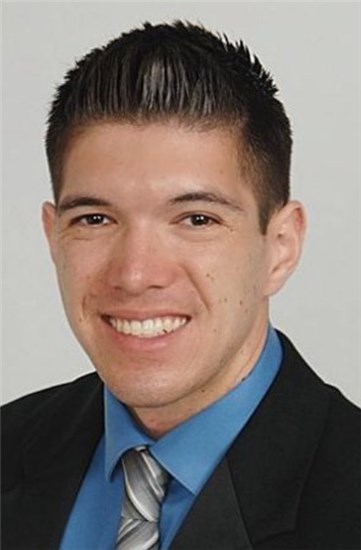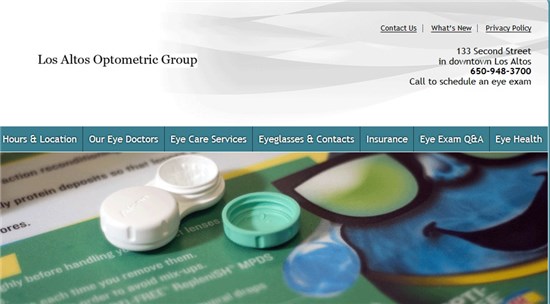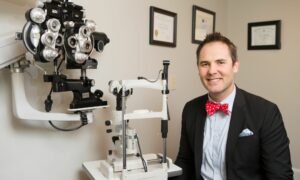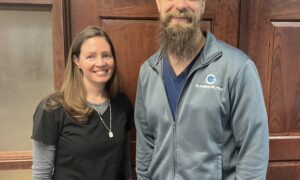By Aaron Neufeld, OD
August 31, 2016

SYNOPSIS
Develop a specialty contact lens niche and serve patients whose vision challenges are not addressed elsewhere. Your clinical excellence will be rewarded with enthusiastic patient recommendations.
ACTION POINTS
CALCULATE POTENTIAL REVENUES. If a specialty, at least $200,000 annually can be generated.
GAUGE ADDED CHAIR TIME. Initial fittings for specialty CL and traditional contact lens patients tend to be comparable time-wise. But additional testing such as corneal topography or anterior segment OCT can lengthen these visits for specialty fits.
INVEST IN INSTRUMENTATION. Corneal topographer (about $12,000) and OCT (about $44,000) are vital for specialty CL patients.
Providing specialty contact lens fittings can be a practice differentiator. And when your practice is a recognized for solving problems that other practices cannot, delighted patients enthusiastically refer other patients.
Currently, we see about 200 specialty contact lens patients in our practice annually. I consider specialty contact lenses to be anything outside of the traditional RGPs and traditional soft lenses offered by the big four (Alcon, Bausch + Lomb, CooperVision and Vistakon). This includes ortho-K/CRT, scleral lenses, hybrid lenses, and a variety of RGP lenses used for specific corneal conditions such as keratoconus. I tend to group multifocal soft lenses in the traditional soft lens realm, rather than considering them a specialty contact lens.
Realize Revenue-Generating Opportunities
I would estimate that roughly about $200,000 worth of revenue comes from our specialty contact lens patients annually.
On average each patient generates $1,000 gross revenue, based on analytics we ran with our patient database. It should be noted that a CRT pateint generates around $1,800 (fit and lenses), while others, like sclerals or bitoric RGPs, produce less. Since we see a fair amount of CRT patients, the average is skewed higher.
These revenues come from both fitting and material fees. The big difference between traditional contact lens patients and specialty contact lens patients is that we receive a lot more revenue from fitting fees.
Additionally, many of our specialty CL patients qualify as medically necessary under insurance plans. This allows more of these patients to embrace a more optimal option for their vision correction (vs. spectacles) without worrying about any financial woes that may be attached. For example: For our our CRT fits: fitting (including all follow-ups for 1 year) $1,300 and CLs=$250 each.
Gauge Needed Chair Time
A good amount of added chair time is necessary for the majority of specialty contact lens patients vs. traditional contact lens patients. Initial fittings for specialty contact lenses and traditional contact lens patients tend to be comparable time-wise. But additional testing, such as corneal topography or anterior segment OCT, can lengthen these visits. There also is sometimes the need for multiple follow-up appointments to get the fit just right.
The art of making specialty contact lens fittings efficient lies in having a solid game plan and timeline for the patient’s visit. Gathering all data in an organized fashion (K readings/topography, manifest refraction, etc.), refining decision-making on the best contact lens option, and training techs to teach insertion and removal, allow for a more efficient visit, and consequently, a better experience for the patient.
Educate Patients On Benefits
Specialty contact lens patients get charged much more than traditional contact lens patients. However, most of this is seen in the fitting cost (in fact materials for certain traditional contact lens patients can end up being more expensive than specialty contact lens materials). For example, a patient with keratoconus, if deemed medically necessary, could be eligible for a large allowance toward specialty lenses and fit. We recently had a keratoconus patient qualify for $1,000 in specialty contact lens benefits due to medical necessity. I would urge optometrists who are interested in this to check medical necessity requirements with all their VCPs and medical plans.
That being said, thorough education about the utility of the contact lenses, the benefits for best corrected visual acuity, and the technology behind designing a specific contact lens to fit the patient’s unique need, helps drive home the worth of the specialty contact lens for the patient. Many patients come into their specialty contact lens fits either in frustration or despair due to lack of viable vision correction options in the past (such as spectacle limitations). Explaining that specialty contact lenses can open many doors in terms of vision gives a patient the passion to pursue better alternatives.
With CRT lenses, many patients appreciate that they are free from any sort of vision correction during waking hours and only have to wear contact lenses during sleep, similar to a retainer used after orthodontic treatment on teeth. This is a great selling point. Additionally, the research supporting myopia control with CRT lenses drives many parents to consider it as an option, especially in a day and age where excessive use of electronic devices has increased the incidence of myopia in children dramatically. Since myopia is often viewed as a disease by parents, they want to limit this disease process as much as possible in their children and are willing to use whatever means necessary.
Invest in Instrumentation
Our corneal topographer and OCT are two instruments (besides the standard slit lamp biomicroscope, phoropter, and autorefractor) that have proven vital to providing the best care to our specialty contact lens patients. Our corneal topographer (Topcon CA-200 Corneal Analyzer) ran about $12,000 and our OCT (Optovue iScan) ran about $44,000.
Within our first few CRT and keratoconus fits after acquiring the corneal topographer we were seeing it generate a profit simply for its necessity in these types of fits. Having detailed information from a corneal topographer helps us achieve better fits in a shorter amount of time and limits the amount of follow-up and contact lens problem visits.
We just acquired our OCT recently, so it is hard to gauge when we will break even/profit, however the OCT has proven to be very valuable in assessing scleral lens fits (looking at edge lift and vaulting, specifically), and similar to the topographer, it allows us to get more accurate the fits the first time around, thus improving overall efficiency. Although Medicare reimbursement has decreased, the OCT is still a versatile instrument in profitability due to its use for our glaucoma patients and other pathologies; and its marketing as an additional in-depth screening tool packaged with our Optomap retinal imaging technology.
Market Specialty CL Services
Marketing for our specialty contact lens services is primarily through word-of-mouth and through surrounding referrals from MDs (and ODs). We strive to provide the best possible experience and fitting process for our specialty contact lens patients and are open to trying whatever solution is necessary (even if it requires exploring a contact lens we are not familiar with). Our drive to go above and beyond is especially appreciated by specialty contact lens patients, since they are often low on options for vision correction, and often this appreciation translates into referrals.
Additionally, we have general information on our specialty contact lens fits on our web site. We also like to educate patients that may be candidates for specialty contact lenses during their exams as a better alternative to their current vision correction.
Develop Referral Relationships with Other ODs & MDs
We get many specialty contact lens patients from MD and OD referrals. The best way to build relationships with these other doctors is to talk to them about the most common ground we share – offering the best possible care to our patients. We have developed a great relationship with our local OMDs that we refer to for cataract, retinal and corneal issues. In return, we often get referrals back for specialty contact lens patients. Since the other OD in our practice has been fitting a variety of specialty contact lenses for a long time, we have earned the reputation as the specialty contact lens practice in our area (almost like our own little niche). This has allowed us to also receive referrals from ODs in the area that do not fit specialty contact lens.
Stay Up-to-Date on Specialty CL Knowledge
Experience and staying current on contact lens technologies are two most important factors when fitting specialty contact lenses. Being a somewhat recent optometry school graduate, I had extensive training (including CRT certification) in fitting most specialty contact lenses during clinical rotations in school. I was interested in this specific subset of optometry, so I actively sought it out. After that, I honed my skills when I entered the real world and started practicing in an office that frequently does specialty contact lens fittings. For other ODs, this may not be the case. However, the lack of experience or education should not hold you back! Various online and literature resources are available to help ODs get up-to-date on specialty contact lens fitting. One may even consider becoming a fellow of the Scleral Lens Society, or other similar endeavors.
On the subject of experience, whenever either my colleague or I have a specialty contact lens patient, we observe each other (time permitting), discuss our results, and keep logs of what works and what does not work. In our profession, we often hear the phrase “the art and science of optometry.” The “science” lies in the cut-and-dry learning phase, which can be done through reading the literature, however the “art” lies in the fitting process that can only be learned through observation and hands-on experience. How one performs the “art” ultimately is the deciding factor for a successful contact lens fit and a happy patient.
For ODs questioning whether to add specialty contact lens fitting to their repertoire of services, I urge you to research different types of specialty contact lenses and talk to other ODs who perform these services. Not only is specialty contact lens fitting financially beneficial to your practice, it also provides an outstanding and important service to a deserving patient population that will help you differentiate your practice in a very positive way.
Educate Staff on Specialty CL Patient Needs
Besides being well versed in insertion and removal techniques for specialty contact lenses, the most important thing that staff needs to know about specialty contact lenses is how they can benefit the patient. Staff can observe this by witnessing a successfully fit specialty contact lens patient and their subsequent elation with their new form of vision correction or through education by the OD. Once staff members see the benefit that specialty contact lenses can provide, they become advocates to patients in need and can be a great marketing tool by providing anecdotal evidence to patients when they are not in the exam room.
Set Expectations with Patients
Most patients coming into a specialty contact lens fit realize that they are, well, special patients with special needs that are out of the norm (the exception being CRT patients). Helping them understand how the contact lens works in correcting vision, especially if it is circumventing a pathology that limits spectacle correction, is always a great start. Preparing a patient by disclosing that multiple visits may be necessary is also important. I normally explain to patients that we are trying a very specialized and customized option for vision correction. It requires a much more involved and detailed experience than a standard spectacle or soft contact lens prescription.
For CRT patients, once again education on how the contact lens works in reshaping the cornea is always a good start. Explaining the various details that go into essentially manipulating biological tissue helps the patient better understand why results may not be instantaneous versus a traditional soft contact lens, and why more chair time is necessary. For younger patients, explaining to the patient and his/her parents about possible myopia control is pertinent as well.
Aaron Neufeld, OD, is the owner of Los Altos Optometric Group in Los Altos, Calif. To contact: aneufeldod@gmail.com




























